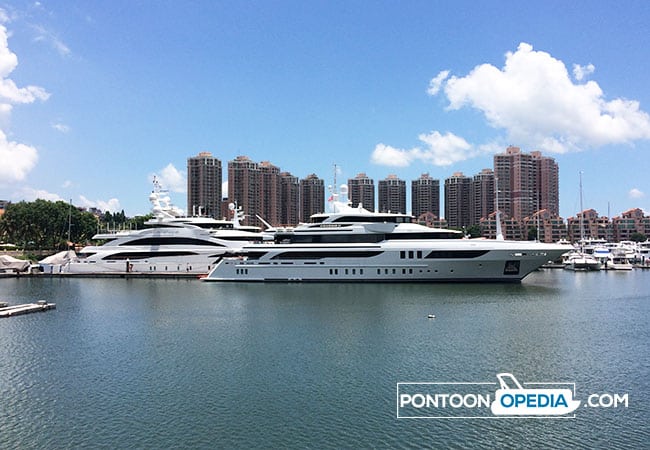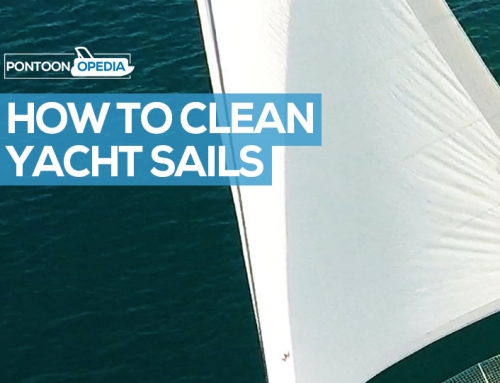Over the last few hundred years, yachts have evolved to become synonymous with luxury and big money. Owning one of these beautiful vessels has become an effortless way of conveying financial success and status.
However, although certain yachts may accurately be called a boat (though you might offend the owner), not all boats can be considered as a yacht. So, when exactly does a boat become a yacht and what’s the difference between a boat and a yacht?
When does a boat become a yacht? There is no strict definition for a yacht, so when a boat becomes a yacht is open to debate. Loosely described, yachts are moderately large sea vessels used for private recreational purposes. A yacht can either be a sail or a power vessel and is typically used for fishing, racing, or cruising.
Table of Contents
What size boat is considered a yacht?
The length that a boat becomes a yacht is also open to debate. However, as a generally accepted guideline, the size a boat is considered a yacht typically start at 9 meters, or 30 feet LOA (length overall). However, when it comes to yachts, what qualifies them over boats is generally elegance and style which are arguably more important than size or length.
A smaller boat might comfortably be called a yacht if it exudes the right level of expense and poise.
Typically, yachts are also non-commercial vessels used for private recreation and leisure. The one exception to this is a yacht for charter.

A boat can become a yacht when it reaches a certain size – look at this huge one in Hong Kong!
Charter yachts are luxury vessels available for hire, which are already fully operated by a professional crew. Although technically commercial vessels, they are nonetheless intended as an indulgent escape for those who can afford it.
Handy Hint: I wrote a guide recently which explains how much it could cost to charter a yacht from the Below Deck TV series.
What is the difference between a boat and a yacht?
When it comes to distinguishing what qualifies a boat and a yacht, the three key differences are the size, purpose, and aesthetics. Below I will explain what the difference is between a boat and a yacht, and how each are qualified.
Boat vs yacht differences
1. Size
Modern naval definitions state that a boat is any floating transport or water vessel that is small enough to be stowed away aboard a ship.
A boat can also be defined as any water vessel or other floating transportation that is under 60 meters (196 feet) LOA. Outside of these very general guidelines, however, there are no real restrictions.
To be classified as a boat, the vessel can be used commercially or non-commercially. There are also no limits on the construction materials used, how its built, or the shape. As a result, anything from a moderately sized yacht to a dinghy can be counted as a boat.
On the other hand, although a yacht can be qualified as a boat as long as it’s under 60 meters LOA, many yachts far exceed this size and length. International shipbuilders are continuously striving to push the envelope, aiming to build increasingly colossal vessels for their customers – many a testament to engineering and design.
These types of yachts, known as Superyachts, Megayachts, or Gigayachts, typically exceed 40 meters LOA. These privately-owned titans are big enough that they need to be operated and maintained by professional crews and are a testament to the enormous wealth of the owner.
As of the beginning of 2019, the largest Superyacht in operation was the Azzam (read more on SuperYacht Times), which boasted a whopping 180 meters (590 feet) LOA. Although it has held the record as the largest privately-owned yacht for just over five years, we will undoubtedly see even bigger yachts with the coming years.
2. Purpose
Another fundamental difference between boats and yachts is how they are used.
A boat can accurately describe a wide range of vessels that are used for both commercial and non-commercial purposes. Dinghies, canoes, houseboats, fishing boats, lifeboats, rowboats, paddleboats, and tugboats all fall under this broad umbrella term.
On the other hand, yachts are almost exclusively non-commercial vessels, designed for personal leisure. Even yachts for charter, which are the only exception to the rule, are specifically intended for luxurious, private getaways.
Another small difference between boats and yachts is where they are used. Boats are more often used on inland waterways, such as canals, rivers, and lakes. Although there are boats that are designed for offshore use, such as certain commercial fishing vessels, most non-commercial boats are rarely taken far off the coast.
On the other hand, while many smaller yachts might be better suited to inland waterways, many larger yachts are perfectly capable of travelling through deeper waters.
3. Aesthetic
Arguably the most significant difference between a yacht and a boat is the difference in aesthetic.
A boat can be anything from an extravagant motorboat to an old canoe, and the appearance or expense of the vessel has very little to do with this classification.
A yacht, on the other hand, is the epitome of luxury and elegance. Originating from the Dutch Republic navy, the name for yachts originally comes from the Dutch word “jacht”, meaning “hunt”.
Originally designed to be light, fast vessels, they were intended for the pursuit of pirates and other criminals around the coasts of the Low Countries.
Their use as leisure vessels was initially popularized by Charles II of England, who first converted one of these boats in 1660 for his own personal use. With this prestigious history, it seems only natural that modern yachts have developed their own unique air of dignity.
Although some owners might still argue that a boat must be over a certain size to be classified as a yacht, in truth, that tends to make very little difference.
If the vessel has elegant lines, a sense of regal poise, and a touch of expense, it can typically be classed as a yacht. For me, this is what qualifies a boat as a yacht in reality!
What qualifies as a Superyacht?
As yachts continue to get bigger and bigger, new terms have emerged to describe these giants, dividing them into the classes of Superyacht, Megayacht, and Gigayacht.
That said, Superyacht and Megayacht are often used interchangeably and are commonly used to describe any yacht over 40 meters (130 feet) LOA.

These super yachts could never qualify as a boat!
Although yacht owners can safely operate a smaller vessel by themselves, once a yacht is big enough to be qualified as a Superyacht, this no longer becomes an option.
These behemoths of the sea are typically run by professional crews and are fully equipped to cater to large groups of passengers. Once in this size class, they are also often fitted with luxury features such as swimming pools and helicopter pads.
If yachts are the epitome of elegance, superyachts are the very definition of big money and luxury.
Yacht size definitions
While there are no official definitions for the range of terms springing up to describe the increasingly large range of yachts released with each passing year, the following terms roughly encompass the following sizes:
- Superyacht: Typically starting at 37 meters (120 feet) from bow to stern, and ranging up to 60 meters (200 feet).
- Megayacht: Although this is often used interchangeably with Superyacht, it can also be used to describe any yacht between 60 metres (200 feet) and 90 metres (300 feet).
- Gigayacht: Used to describe any yacht over 90 metres (300 feet) from bow to stern.
That said, these terms seem to be constantly evolving, and we may see a change in how they are used with the coming years.
Other types of yacht classifications
Although Superyachts tend to overshadow anything else compared to them, there are still countless variations within the smaller types of yachts available.
Some of the most popular classifications for standard yachts are:
1. Day Cruiser
One of the most pared-down yacht variations. Sporting a single, open deck and no cabin, these types of yachts have fewer luxuries than some of the other types of yachts available.
For those buyers looking for nothing more than a sun-soaked afternoon with friends or family, this is an ideal choice.
2. Weekender
Depending on the size of the yacht, a Weekender will have either one or two cabins that tend to be small and quite basic in function. Weekender yachts also tend to have a small kitchen, or galley, unit, and basic plumbing.
As the name would suggest, this type of yacht is designed to accommodate a few guests for one or two nights.
3. Cruisers
A step up from the Weekender yacht, Cruisers have everything needed for an extended stay on board. Owners of these boats will have everything needed for a long vacation and may even choose to live aboard permanently if they wish.
4. Sport fishing yachts
Similar to the Cruiser, but with additional features for the avid fisher. These vessels tend to have one or more cabins, a galley, basic plumbing, and all the fishing equipment needed for an extended trip.
5. Luxury yachts
A step up from Cruisers, Luxury yachts offer all of the features for an extended stay, but with more space and comfort. As the name suggests, the emphasis is on a luxurious experience, and most yachts in this class feature all the necessary amenities to assist with this.
One of the most popular manufacturer of luxury yachts in the world is the UK-based Sunseeker company. Visit their website to see how their yachts are very different to boats you might see on your everyday maritime travels.
6. Racing yachts
On the opposite end of the scale from yachts that aim for comfort above anything else, racing yachts tend to sacrifice comfort for speed.
These sail yachts are often stripped-down variations of the classic yacht, designed with a light frame and a deep, heavy keel to allow for a tall mast and a large sail. Typically featuring only the most basic amenities, they can be designed to cater to crews of between 1-30 people.
The last word…
As you can see, there is no universal classification for when a boat become a yacht, or even what size boat is considered a yacht. Ultimately, it’s down to how we perceive them to be.
If you want to know more about yachting life, here are a few extra articles you might enjoy:






